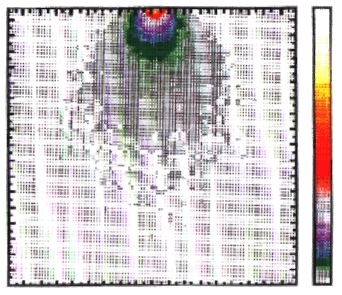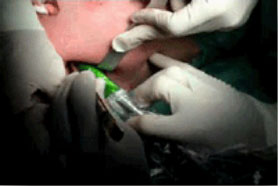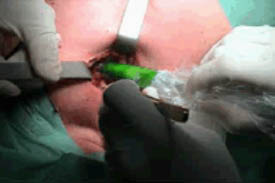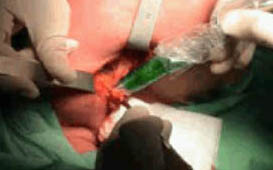Technical Features
Gamma sup was created in order to achieve two main goals :
![]() Detection of the SLNB or small tumours.
Detection of the SLNB or small tumours.
![]() Make the surgical act easier to the surgeon.
Make the surgical act easier to the surgeon.
Intraoperative Gamma Sup probes can be used successfully in :
![]() The SLNB detection in Breast & Skin cancer.
The SLNB detection in Breast & Skin cancer.
![]() The endocrine tumours detection
The endocrine tumours detection
![]() The genitals tumours detection
The genitals tumours detection
Gamma Sup presents a very high sensitivity whatever the gamma rays isotope used:
![]() Tech-99
Tech-99
![]() Indium-111
Indium-111
![]() Iode-131l
Iode-131l
Intraoperative Gamma probe has been customised for the Sentinel Lymph Node detection, the surgeon uses it during the surgery, its adjustable threshold with original sound and the four number digit allows an interactive use. The probes dimensions and technical proficiencies can be customised upon request.
Proficiencies :
![]() Energy range between 0-400 keV it can be adapted till 511keV thanks to an additional collimator.
Energy range between 0-400 keV it can be adapted till 511keV thanks to an additional collimator.
![]() Great efficiency in beats/kbq studied with a 57co source : (d = distance between the source and the probe) :
Great efficiency in beats/kbq studied with a 57co source : (d = distance between the source and the probe) :
![]() High sensitivity collimator: 10.2 on d = 1cm and 1.6 on d = 3 cm
High sensitivity collimator: 10.2 on d = 1cm and 1.6 on d = 3 cm
![]() High resolution collimator: 3.0 on d = 1cm and 1.0 on d = 3 cm
High resolution collimator: 3.0 on d = 1cm and 1.0 on d = 3 cm
![]() Lateral resolution in cm (LHM) studied with a 57co source : (d = distance between the source and the probe) :
Lateral resolution in cm (LHM) studied with a 57co source : (d = distance between the source and the probe) :
![]() High sensitivity collimator: 1.5 on d = 1cm and 3.0 on d = 3 cm
High sensitivity collimator: 1.5 on d = 1cm and 3.0 on d = 3 cm
![]() High resolution collimator: 0.5 on d = 1 cm and 1.2 on d = 3cm
High resolution collimator: 0.5 on d = 1 cm and 1.2 on d = 3cm
Remarks The technical proficiencies of the 12-mm probe and the 14mm probe are equal. The only difference stands in the shield wide: the 12-mm probe is mainly used for 99tc detection.
Full set including :
![]() class II a device
class II a device
![]() 12 or 14 mm probe, 20 cm long, with an integrated gold collimator
12 or 14 mm probe, 20 cm long, with an integrated gold collimator
![]() connecting cable made of PVC
connecting cable made of PVC
![]() stainless steel cylinder
stainless steel cylinder
![]() control unit with one channel
control unit with one channel
![]() box for transport and storage
box for transport and storage
Control unit features
![]() ABS unit
ABS unit
![]() front part made of lexan
front part made of lexan
![]() power supply : 220 V
power supply : 220 V
![]() counting rate visualised in real time on a 4 digit display
counting rate visualised in real time on a 4 digit display
![]() pre-set time for counting
pre-set time for counting
![]() audio-signal with adjustable threshold
audio-signal with adjustable threshold
![]() dimensions : 30,2 * 25,3 * 10,1 cm
dimensions : 30,2 * 25,3 * 10,1 cm
![]() weight : 3,5 kg
weight : 3,5 kg
Probe features :
| Parameters | Features |
| Detector | - Thallium activated caesium iodine scintillating crystal - Photomultiplier tube |
| Collimator | - Integrated, made of gold - 6 mm opening window |
| Shield | - 12 mm probe : 99% on the 99 mTc (140 keV) - 14 mm probe : 74% on the 131 I ( 364 keV) - Probe FDG : 80% on the 511 keV |
| Energy field | 40/400 keV |
| Detection efficiency | 6,5 bts/kBq on 1cm - 0,8 bts/kBq on 3 cm |
| Body surface | stainless steel |
| Dimensions | Ext. diam * length : 14 * 200 mm or 12 *200 mm |
| Connecting cable | One cable with PVC slipcover |
| Connection | Waterproof Fischer connector |
| Weight | 350g |
12 mm probe collimator answers
| High resolution collimator | Usual collimator |
 |
 |
The high resolution collimator obtains a narrow field around the detection area which allows great discrimination for the detection ( inferior to 1 cm ). It is particularly well adapted in cases where the Sentinel Lymph Node is really close to the injection points ( producing gamma-rays that can parasite the detection ).
The high sensitivity collimator with its wide detector range is characterised by a very high sensitive detection. This is really useful for the pre-operative detection especially when the Sentinel Lymph Node is in depth.
Hight resolution probe and standart probe sensitivity in the air
Thanks to a large study on the collimating device it appears that the high resolution probe answer is the equivalent of the standard probe answer beyond 3 cm, which is the standard depth of the Sentinel Lymph Node.
Gamma-Sup was developed afterwards the numerous studies on the Sentinel Lymph Node
This is an historical summary of the beginnings of the Sentinel Lymph Node preoperative detection.
![]() In 1977 : R.M Cabanas defines the Sentinel Lymph Node term which is the first functional node in the lymphatic irrigation of a tumour
in the case of penis cancer.
In 1977 : R.M Cabanas defines the Sentinel Lymph Node term which is the first functional node in the lymphatic irrigation of a tumour
in the case of penis cancer.
![]() In 1992 : D.L Morton and his team (oncology surgery 1992) describe the Sentinel Lymph Node detection by peri-tumoral injection of blue dye in case of melanoma. The node appears to be the best representative of the tumour progression in the lymphatic system ( in 99% of the cases ).
In 1992 : D.L Morton and his team (oncology surgery 1992) describe the Sentinel Lymph Node detection by peri-tumoral injection of blue dye in case of melanoma. The node appears to be the best representative of the tumour progression in the lymphatic system ( in 99% of the cases ).
![]() In 1993 : J.C Alex and D.N Krag apply the Sentinel Lymph Node pre-operative detection at the melanoma (oncology surgery 1993; 2; 303-308). They report a very high sensitivity in the breast cancer method (oncology surgery 1993; 2; 335-340).
In 1993 : J.C Alex and D.N Krag apply the Sentinel Lymph Node pre-operative detection at the melanoma (oncology surgery 1993; 2; 303-308). They report a very high sensitivity in the breast cancer method (oncology surgery 1993; 2; 335-340).
The remarkable results of these teams in pre-operative detection have been confirmed by many others teams
![]() Pijpers R. et al. (Amsterdam). World J. Surg. 1997 ; 21 :788-792. " Biopsy of the first tumor-draining lymph node (sentinel node) is bound to become the procedure of choice in regional staging of melanoma patients. A tumor-negative sentinel node virtually excludes lymphatic metastases and obviates the need for lymph node dissection ".
Pijpers R. et al. (Amsterdam). World J. Surg. 1997 ; 21 :788-792. " Biopsy of the first tumor-draining lymph node (sentinel node) is bound to become the procedure of choice in regional staging of melanoma patients. A tumor-negative sentinel node virtually excludes lymphatic metastases and obviates the need for lymph node dissection ".
![]() Albertini J.J. et al. (Tampa). Ann. Surg. ; 1996 ; 223 :217-224. " The use of intraoperative radiolymphoscintigraphy can improve the identification of all sentinel lymph nodes during selective lymphadenectomy.
Albertini J.J. et al. (Tampa). Ann. Surg. ; 1996 ; 223 :217-224. " The use of intraoperative radiolymphoscintigraphy can improve the identification of all sentinel lymph nodes during selective lymphadenectomy.
![]() Alex J.C. & Krag D.N. (Burlington). Surg. Oncol. Clin. Am. 1996 ; 5 :33-41. " Our experience with squamous cell carcinoma of the head and neck and Merkel cell carcinoma suggests that the assessment of the regional lymphatics using the gamma-probe technology for identification of the primary node may also be applicable to many other solid tumors ".
Alex J.C. & Krag D.N. (Burlington). Surg. Oncol. Clin. Am. 1996 ; 5 :33-41. " Our experience with squamous cell carcinoma of the head and neck and Merkel cell carcinoma suggests that the assessment of the regional lymphatics using the gamma-probe technology for identification of the primary node may also be applicable to many other solid tumors ".
![]() EORTC breast cancer cooperative group, Sept. 2000. " The sentinel node concept in breast cancer has proven to be valid.
Inbexperienced hands, the sentinel node procedure in invasive breast cancer can be considered as an equal staging procedure as axillary lymph node dissection ".
EORTC breast cancer cooperative group, Sept. 2000. " The sentinel node concept in breast cancer has proven to be valid.
Inbexperienced hands, the sentinel node procedure in invasive breast cancer can be considered as an equal staging procedure as axillary lymph node dissection ".









